Kidney removal - discharge
You had surgery to remove part of one kidney or the entire kidney, the lymph nodes near it, and maybe your adrenal gland. This article tells you how to take care of yourself when you leave the hospital.
Kidney
Kidney removal, or nephrectomy, is surgery to remove all or part of a kidney. It may involve:Part of one kidney removed (partial nephrectomy). All o...

When You're in the Hospital
You may have an 8- to 12-inch (20- to 30-centimeters) surgical cut over your belly or along your side. If you had laparoscopic surgery, you may have three or four small cuts.
What to Expect at Home
Recovering from kidney removal most often takes around 3 to 6 weeks. You may have some of these symptoms:
- Pain in your belly or on the side where you had the kidney removed. The pain should get better over several days to a week.
- Bruising around your wounds. This will go away on its own.
- Redness around your wounds. This is normal.
- Pain in your shoulder if you had laparoscopy. The gas used in your belly can irritate some of your abdomen muscles and radiates pain to your shoulder.
Activity
Plan to have someone drive you home from the hospital. Do not drive yourself home. You may also need help with everyday activities for the first 1 to 2 weeks. Set up your home so it is easier to use.
Set up your home
Getting your home ready after you have been in the hospital often requires much preparation. Set up your home to make your life easier and safer when...
Read Article Now Book Mark ArticleYou should be able to do most of your regular activities within 4 to 6 weeks. Before then:
- Do not lift anything heavier than 10 pounds (4.5 kilograms) until you see your surgeon.
- Avoid all strenuous activity, including heavy exercises, weightlifting, and other activities that make you breathe hard or strain.
- Taking short walks and using the stairs is OK.
- Light housework is OK.
- Do not push yourself too hard. Slowly increase the amount of time and the intensity of your exercise. Wait until you follow up with your surgeon to be cleared for exercise.
To manage your pain:
- Your surgeon will prescribe pain medicines for you to use at home.
- If you are taking pain pills 3 or 4 times a day, try taking them at the same times each day for 3 to 4 days. They may work better this way. Be aware that the pain medicine can cause constipation. Try to maintain normal bowel habits.
- Try getting up and moving around if you are having some pain. This may ease your pain.
- You may put some ice over the wound. But keep the wound dry.
Press a pillow over your incision when you cough or sneeze to ease discomfort and protect your incision.
Make sure your home is safe as you are recovering.
Home is safe
Getting your home ready after you have been in the hospital often requires much preparation. Set up your home to make your life easier and safer when...
Read Article Now Book Mark ArticleWound Care
You will need to keep your incision area clean, dry, and protected. Change your dressings the way your provider taught you to.
- If stitches, staples, or glue were used to close your skin, you may take a shower.
- If tape strips were used to close your skin, cover the wounds with plastic wrap before showering for the first week. Do not try to wash the tape strips off. Let them fall off on their own.
Do not soak in a bathtub or hot tub, or go swimming, until your provider tells you it is OK.
Diet
Eat a normal diet. Drink 4 to 8 glasses of water or liquids a day, unless you are told otherwise.
If you have hard stools:
- Try to walk and be more active. But do not overdo it.
- If you can, take less of some of the pain medicines your doctor gave you. Some can cause constipation.
- Try a stool softener. You can get these at any pharmacy without a prescription.
- Ask your health care provider what laxatives you can take.
- Ask your provider about foods that are high in fiber, or try psyllium (Metamucil).
When to Call the Doctor
Call your surgeon if:
- You have a temperature above 100.5°F (38°C)
- Your surgical wounds are bleeding, are red or warm to the touch, or have a thick, yellow, green, or milky drainage
- Your belly swells or hurts
- You have nausea or vomiting for more than 24 hours
- You have pain that does not get better when you take your pain medicines
- It is hard to breathe
- You have a cough that does not go away
- You cannot drink or eat
- You cannot pee (urinate)
Reviewed By
Kelly L. Stratton, MD, FACS, Associate Professor, Department of Urology, University of Oklahoma Health Sciences Center, Oklahoma City, OK. Also reviewed by David C. Dugdale, MD, Medical Director, Brenda Conaway, Editorial Director, and the A.D.A.M. Editorial team.
Moriera DM, Kavoussi LR. Laparoscopic and robotic surgery of the kidney. In: Partin AW, Domochowski RR, Kavoussi LR, Peters CA, eds. Campbell-Walsh-Wein Urology. 12th ed. Philadelphia, PA: Elsevier; 2021:chap 102.
Olumi AF, Blute ML. Open surgery of the kidney. In: Partin AW, Domochowski RR, Kavoussi LR, Peters CA, eds. Campbell-Walsh-Wein Urology. 12th ed. Philadelphia, PA: Elsevier; 2021:chap 101.
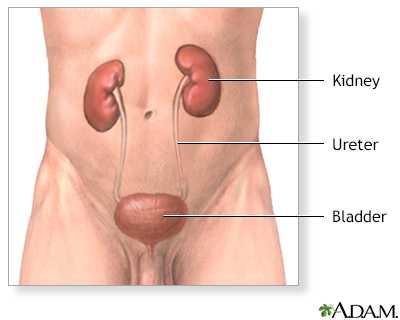

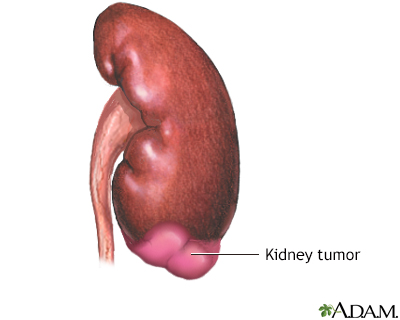
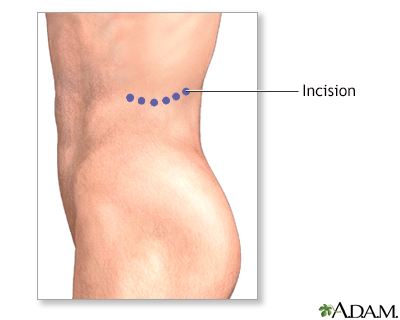
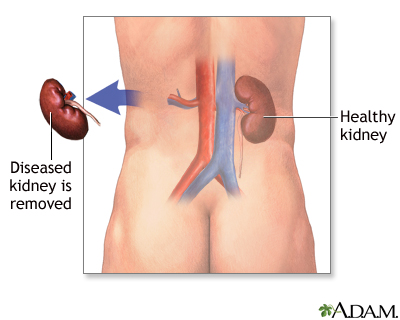
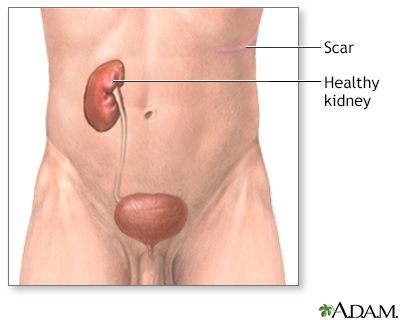
 All rights reserved.
All rights reserved.